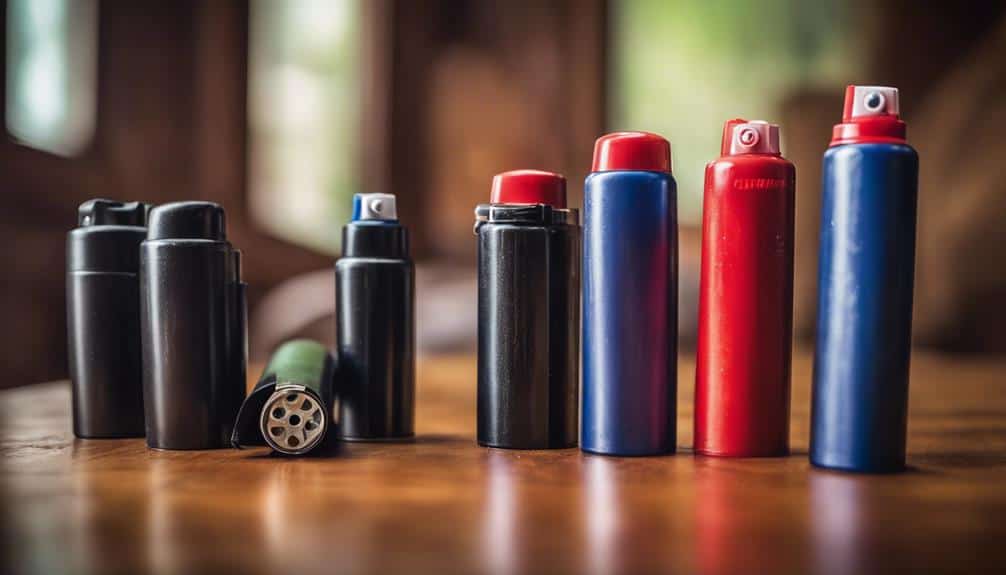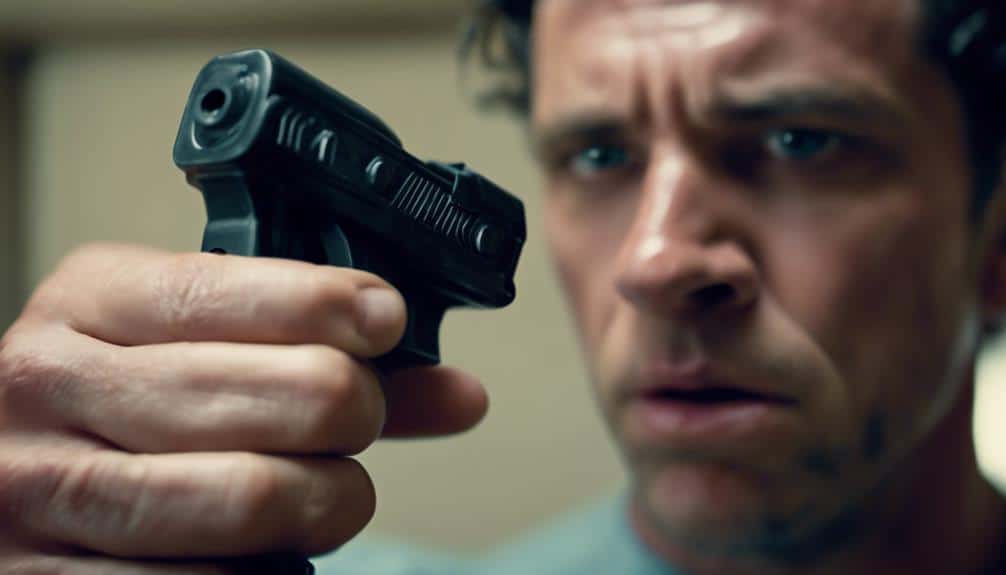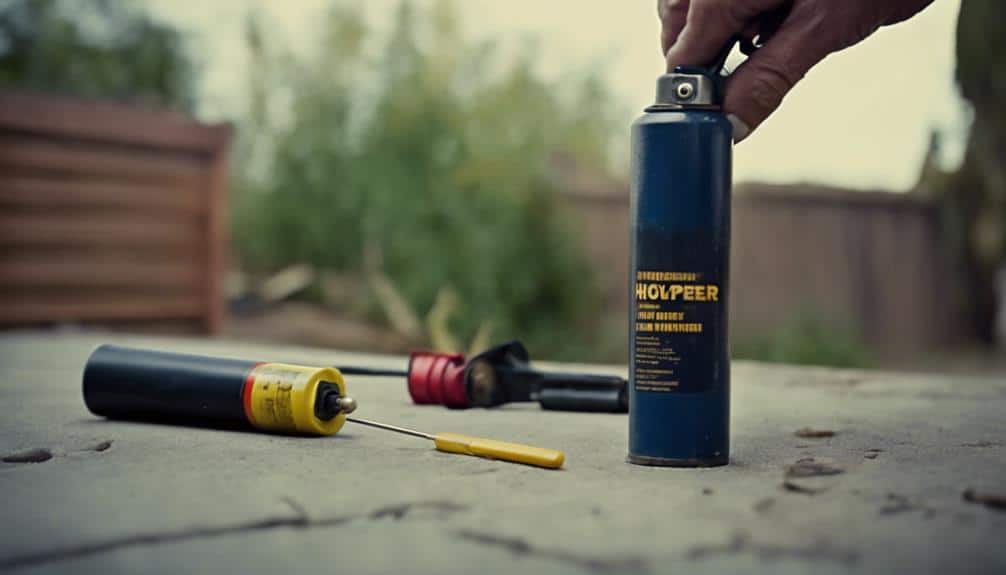Carrying
pepper spray is a smart move for
personal safety, but doing it right is key! First,
choose the right type—traditional spray or pepper gel, both have their perks. Make sure it’s super strong and has safety features to avoid any “oops” moments.
Know the laws in your area; you don’t want a run-in with the law.
Practice makes perfect, so get comfortable with your spray. Keep it within arm’s reach, especially in sketchy situations. Inspect it often and store it properly—in a drawer, on a high shelf, or in a lockable box. Want to feel safer and more confident? There’s more ahead for you!
Choose the Right Spray
When choosing the right pepper spray, you’ll want to contemplate both the type and its effectiveness.
First, decide if you prefer
traditional spray or
pepper gel. Traditional spray offers a wider dispersal, making it great for covering a large area, but it can be impacted by wind. On the other hand, pepper gel provides better accuracy and isn’t as affected by windy conditions, so it might be your best bet for outdoor use.
Next, focus on the
strength of the spray. Look for
maximum strength formulations that contain higher concentrations of oleoresin capsicum (OC). This guarantees you have a potent self-defense tool.
Don’t forget to check if the pepper spray canisters have a
safety mechanism. This feature is vital to prevent accidental discharge, especially if you’re carrying the spray in your bag or pocket.
Some canisters also come with
UV marking dye, which is super handy. It can help law enforcement identify your attacker later on.
Understand Legal Restrictions
Understanding the legal restrictions around pepper spray is essential to guarantee you’re compliant and can confidently carry your self-defense tool. You don’t want to be caught off guard by unexpected rules, so let’s break it down.
First, familiarize yourself with state and local laws. Regulations can be a patchwork, varying wildly from one place to another. Some states might restrict the size, strength, or even the type of pepper spray you can use. And don’t forget age requirements—often, you need to be 18 or 21 to purchase it legally.
Next, be mindful of specific locations where pepper spray is a no-go. Schools, government buildings, and airports typically ban it. Imagine reaching for your spray in a pinch only to realize you’re in big trouble for just having it there!
| Location |
Restriction |
| Schools |
Prohibited |
| Government Buildings |
Prohibited |
| Airports |
Prohibited |
Stay updated! Laws change, and you want to be in the know. Some states even require you to register your pepper spray. It sounds like a hassle, but knowing your rights means you can use pepper spray confidently and legally.
Practice Deployment Techniques
When practicing your
pepper spray deployment, grip it firmly and focus on aiming for the attacker’s face to maximize its effectiveness.
Test your skills regularly in a safe,
controlled environment to build muscle memory and confidence.
Aim and Fire Techniques
How can you guarantee effective self-defense with pepper spray? It all comes down to mastering aim and fire techniques. Practice regularly to develop muscle memory, ensuring you have a firm grip with your thumb on the trigger for quick deployment. You’ve got to know your pepper spray inside and out. Familiarize yourself with different dispersal types, such as stream and fog. Streams are your best bet for accuracy and wind resistance, especially when aiming for an attacker’s face.
Keep an appropriate distance—at least two arm lengths—so you minimize the risk of getting counterattacked while still ensuring effective coverage. Use short bursts. Not only will this prevent over-spraying, but it’ll also help you maintain control over the spray’s direction and distance.
Here’s a quick comparison to help you out:
| Technique |
Description |
| Grip |
Thumb on trigger, firm hold |
| Distance |
Two arm lengths from attacker |
| Burst |
Short bursts to control spray |
| Dispersal |
Stream for accuracy & wind resistance |
These tips will help when you use your pepper spray. Practice makes perfect, so don’t skip out on regular drills. Remember, confidence in your skills can make all the difference in a tense situation. Stay safe, stay prepared!
Regular Testing Protocols
Practicing
regular testing protocols guarantees your pepper spray is always
ready and effective when you need it most. You don’t want to find out your pepper spray is a dud in the middle of an emergency, right? Testing your canister every 90 to 180 days confirms it’s
functional.
Grab that canister, find a controlled environment, and practice your grip and aim.
Muscle memory is key here; the more you practice, the more confident and quick you’ll be when it counts.
Don’t forget to check the
spray levels regularly. Testing does use up some of the contents, so you’ll want to be certain you’re not running low. Familiarize yourself with the
safety mechanisms, too. Practice disengaging them quickly; you don’t want to fumble when you’re in a pinch.
Aim to mix up your
practice conditions. Try
different distances, and for a real challenge, test in various wind directions. This way, you’ll be prepared for whatever Mother Nature throws your way.
Learning how to use your pepper spray effectively isn’t just smart; it’s essential for your safety. And hey, a little practice never hurt anyone—except maybe that practice dummy!
Ensure Easy Accessibility
Keep your
pepper spray within arm’s reach to guarantee it’s ready for
immediate use during an emergency. This self-defense tool is only effective if you can actually get to it when you need it. Imagine fumbling through your purse or glove compartment while an attacker is closing in.
Instead, store your pepper spray in
easily reachable spots like an outer jacket pocket or attached to your keychain. It’s all about ensuring you can grab it in a split second.
When
walking in potentially unsafe areas, hold your pepper spray in your hand. Picture yourself walking through a
dark parking lot at night—keeping your spray ready can make all the difference. Avoid stashing it in places that are hard to access quickly, like deep inside a bag or in your car.
The
21-foot rule stresses how quickly someone can close that distance, so you need to be faster. Don’t forget to
evaluate your environment and habits. If you’re out jogging in a secluded area or heading out at night, make sure your pepper spray is right where you need it.
Practice retrieving it regularly to build muscle memory, so in a real emergency, you’ll react without hesitation.
Regular Maintenance and Testing
Regularly testing and maintaining your pepper spray is essential to guarantee it works when you need it most.
Test your canister every few months to avoid any nasty surprises, and always keep an eye on the
expiration date.
If the canister looks beat up or has been stored in extreme temperatures, it’s time for a new one—better safe than sorry!
Ensure Functionality Regularly
To guarantee your pepper spray is always ready for use, test the canister every 90-180 days to confirm it functions properly. Regular maintenance can mean the difference between safety and vulnerability.
First, always check the expiration date on your pepper spray. This little detail often gets overlooked, but it’s essential. A typical canister has a lifespan of 2-4 years, and once it expires, its effectiveness can dwindle faster than you’d expect.
Next, verify functionality regularly by inspecting the canister for any physical damage. Look for dents, leaks, or anything that seems off. You don’t want to discover a malfunction when you need it the most.
Here’s a quick visual checklist to keep things simple:
- Expiration Date: Check and mark it on your calendar.
- Physical Damage: Inspect for dents, leaks, or wear.
- Test Spray: Give it a test spray every 90-180 days.
Lastly, store your pepper spray in a cool, dry place, away from direct sunlight and extreme temperatures. This will help maintain its effectiveness over time.
Trust me, you’ll feel a lot safer knowing your pepper spray is in top shape, ready to protect you when you need it.
Avoid Malfunctions
Make certain your pepper spray doesn’t fail you by inspecting it for clogs and
physical damage regularly. You don’t want to be caught off guard in a sticky situation because your spray decided to take a nap. To avoid
malfunctions, give your canister a good look-over every 90-180 days. Check for any signs of wear and tear; even the smallest crack can spell disaster.
Don’t forget to inspect the nozzle. A
clogged nozzle can turn your trusted defense tool into a useless hunk of plastic. Simply give it a clean to keep your pepper spray ready for action. And hey, if you notice it’s nearing the end, replace it before it sputters out on you.
Storing your pepper spray is just as important. Keep your pepper spray in a cool,
dry place, and make sure it stays above 32°F. This helps
maintain its performance and guarantees it sprays the right distance when you need it most.
Effective Storage Solutions
Store your pepper spray in a cool, dry place at room temperature to maintain its effectiveness. You don’t want it to lose its punch when you need it most!
Keeping it out of reach of children and pets is essential too, as a wandering toddler or curious cat might accidentally set it off.
Here are some effective storage solutions to take into account:
- Bedroom Drawer: Tuck it away in your nightstand drawer. It’s easily accessible for you but out of reach for little hands or paws.
- High Shelf: Place it on a high shelf in a closet. This keeps it away from kids but still within your grasp.
- Dedicated Storage Box: Use a small, lockable box for added security. It’s particularly helpful if you have young children who love exploring.
Remember to check the expiration date regularly. Pepper spray usually lasts around 2-4 years, so you’ll want to replace it when it’s past its prime.
Don’t leave it in your car during sweltering summers, either. High temps can make it burst or leak—definitely not the surprise you want on a hot day!
And keep it out of direct sunlight; too much sun can degrade its potency.
Stay Aware and Prepared
Now that your
pepper spray is stored safely, it’s time to focus on staying aware and prepared for any situation.
First off, always keep your pepper spray in an
easily accessible spot, like in your hand or a quick-access pocket. This way, you’re ready to react instantly if needed. Imagine fumbling around in your bag during a tense moment—no thanks!
Being mindful of your surroundings is essential. Make it a habit to scan your environment regularly. Think of it as your personal safety radar. Notice who’s around, what they’re doing, and any exits or safe spots. Your
situational awareness is your
first line of defense.
Next,
practice makes perfect. Regularly rehearse gripping, aiming, and firing your pepper spray. It might seem silly at first, but
muscle memory is your friend here. Picture yourself in a tough spot—confidence comes from knowing you’ve got this.
Don’t forget to
check the weather. Wind can mess with your spray’s accuracy, so be aware of its direction.
Finally, know the
local laws about pepper spray. You don’t want to be caught off guard by legal issues when you’re just trying to stay safe.
Stay aware and prepared, and you’ll be ready for anything!
Frequently Asked Questions
Where Is the Best Place to Carry Your Pepper Spray?
The best place to carry your pepper spray is on a keychain or in an outer jacket pocket. This guarantees ideal storage and accessibility considerations, allowing you to quickly retrieve it during emergencies without fumbling.
What Are the Precautions for Pepper Spray?
You should know the legal considerations for carrying pepper spray in your area. Choose the right pepper spray types for your needs, store it safely, check expiration dates, and avoid self-contamination by not touching your face.
What Can Protect You From Pepper Spray?
To protect yourself from pepper spray, use defenses like protective eyewear, masks, and tightly woven clothing. Consider pepper spray alternatives such as personal alarms or stun guns to minimize the risk of accidental exposure.
What Is the Best Practice of Pepper Spray?
The best practice for pepper spray involves mastering self-defense techniques and understanding legal regulations. Always carry it accessibly, aim for the face, practice regularly, and know your spray’s type. Check expiration dates to verify effectiveness.








